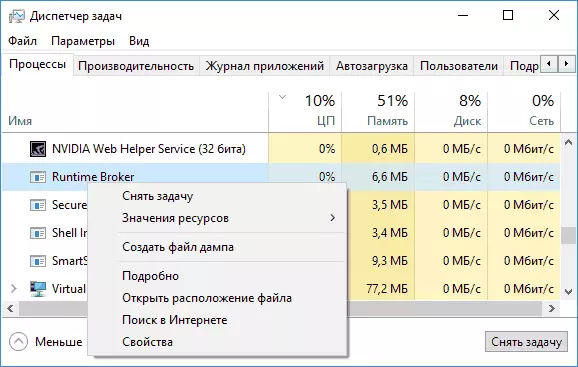
Immediately what Runtime Broker is more accurate for which this process is responsible: it manages the permissions of modern UWP applications Windows 10 from the store and usually does not occupy a significant amount of memory and does not use a noticeable number of other computer resources. However, in some cases (often due to incorrectly operating application), it may not be so.
Correction of high load on the processor and memory caused by Runtime Broker
If you encountered high resources with the RuntimeBroker.exe process, there are several ways to correct the situation.Removing the task and reboot
The first such method (for the case when the process uses a lot of memory, but can be used in other cases) is offered on the official Microsoft website and is very simple.
- Open the Windows 10 task manager (Ctrl + Shift + Esc keys, or right click on the Start button - Task Manager).
- If only active programs are displayed in the task manager, press the "More" button at the bottom left.
- Find in the Runtime Broker list, select this process and click the "Remove Task" button.

- Restart the computer (run the restart, and not shutting down and re-inclusion).
Deleting an application calling
As noted above, the process is related to applications from the Windows 10 store and, if the problem has appeared after installing some new applications, try removing them if they are not necessary.You can delete the application using the application tile context menu in the Start menu or in the parameters - applications (for versions to Windows 10 1703 - Parameters - System - Applications and Opportunities).
Disable Windows 10 Application Functions
The following possible option capable of helping the high load correction called Runtime Broker is to disable some features related to store applications:
- Go to the parameters (Win + I keys) - Privacy - Background applications and disconnect applications in the background. If it worked, in the future you can enable permission to work in the background for applications one by one until the problem has been detected.

- Go to the parameters - the system - notifications and actions. Disable "Show Tips, Tips and Recommendations when using Windows". It can also work off the notifications on the same settings page.

- Restart the computer.
If nothing has helped from this, you can try to check, and is it really a system Runtime Broker or (which may be in theory) - third-party file.
Checking RuntimeBroker.exe for viruses
To find out if the runtimebroker.exe is a virus, you can perform the following simple actions:
- Open the Windows 10 task manager, find in the Runtime Broker list (or runTimeBroker.exe on the "Details" tab, click on it right-click and select "Open File Location".
- By default, the file should be located in the Windows \ System32 folder and, if you right-click on it and open the "Properties", then on the Digital Signature tab you will see that it is signed by Microsoft Windows.

If the location of the file is different or no digital signature, check it on the viruses online with Virustotal.
